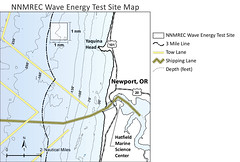NEWPORT – A new iPhone application gives visitors an inside look at Oregon’s newest state park, the Beaver Creek State Natural Area south of Newport.
The application, “Paddle Beaver Creek,” was developed jointly by the Oregon Parks and Recreation Department and Oregon Sea Grant at Oregon State University. It is available free for downloading from the iPhone store.
The project is designed to provide park visitors with an additional way to learn more about the park. “We are adapting to the needs of present and future generations of park visitors,” stated Mike Rivers, Ranger Supervisor for Oregon State Parks. “Having a park-specific smart phone guide to water trails, wildlife and natural history will hopefully deepen our visitors’ experiences in Oregon State Parks’ 2010 park of the year, Beaver Creek State Natural Area.”
The core of the application is an interactive map of the Beaver Creek Water Trail – about three scenic miles of an easy-paddling waterway in a pristine coastal marsh open to kayaks and canoes. With no feasible way to post interpretive signs along a water trail, the application provides iPhone-equipped canoeists and kayakers a way to track their progress via GPS, and interactively highlights points of interest along the way, from nesting ospreys to beaver lodges.
Oregon Sea Grant’s interest in developing new tools for effective science education brought them to this cooperative project. “We are always exploring tools that deepen understanding of the coast,” said Dr. Shawn Rowe, Sea Grant Extension’s free-choice learning specialist at the Hatfield Marine Science Center in Newport. “Giving visitors the ability to seek the depth of information they prefer is the future of parks and interpretive centers.”
Beaver Creek State Natural Area is located seven miles south of Newport, just east of Ona Beach State Park. The park, which celebrated its grand opening Oct. 1, offers recreation for boaters and nonboaters alike. A newly created Visitor Center features interpretive exhibits, an ADA-accessible deck overlooking the wetland, and trail access. Free Wi-Fi access allows visitors to download the iPhone App on the spot.
Other Sea Grant personnel involved in conceptualizing and creating the application and coordinating logistics include Mark Farley, Nancee Hunter, Joe Cone and Evelyn Paret. Plans are in the works for additional applications, in versions for a variety of mobile smart-phone platforms.
Oregon Sea Grant, founded in 1968 and based at Oregon State University, supports research, education, and public engagement to help people understand, responsibly use, and conserve ocean and coastal resources.
 Immersion suits, also called survival suits, have helped saved hundreds of lives, largely because they provide protection from hypothermia. However, the protection of a survival suit is only good if it’s on; and during at-sea emergencies, there may be only seconds to put the bulky items on. This video shows the proper techniques for donning immersion suits and entering the water.
Immersion suits, also called survival suits, have helped saved hundreds of lives, largely because they provide protection from hypothermia. However, the protection of a survival suit is only good if it’s on; and during at-sea emergencies, there may be only seconds to put the bulky items on. This video shows the proper techniques for donning immersion suits and entering the water.



